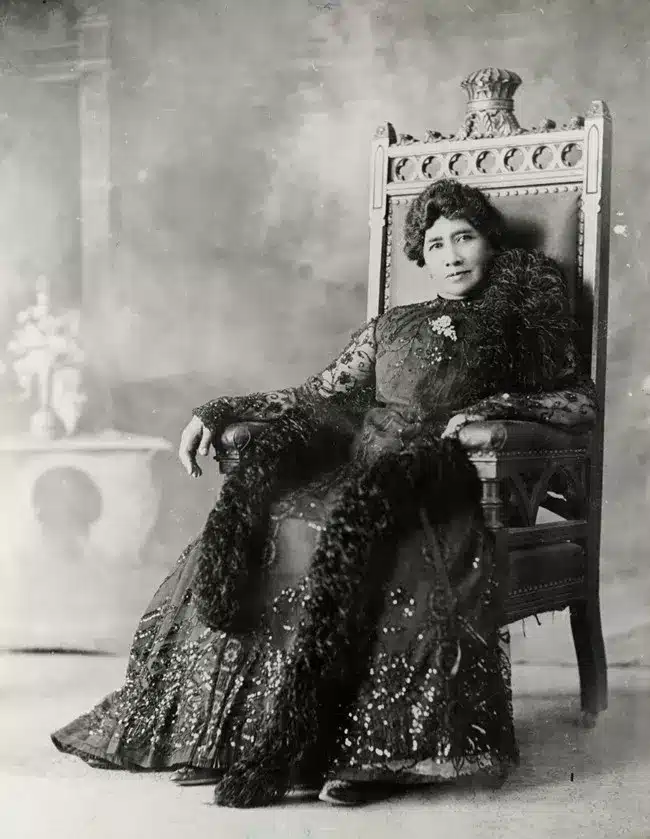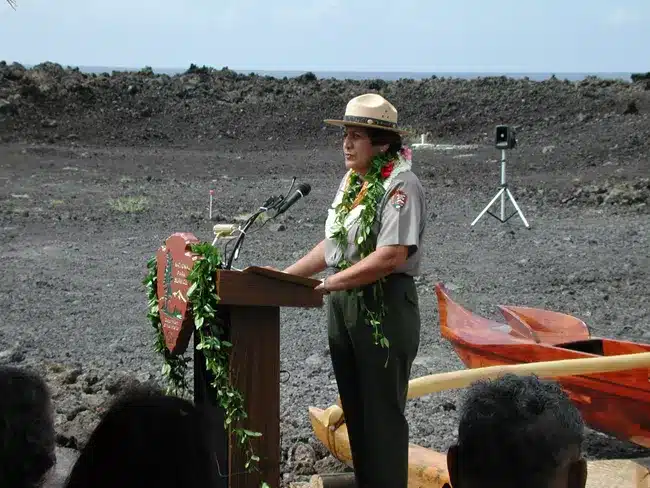March is Women’s History Month and here in Volcano, Hawai’i, we’re honoring the commitment of some incredible women who have helped make Hawai’i Volcanoes National Park what it is today. Like Madam Pele herself, women have always played an integral role here, so let’s take a look at some of the brilliant women who have shaped the park and all of Hawai’i over the years.
Queen Lili‘uokalani
Queen Lili‘uokalani, the last sovereign of Hawai’i, was born on September 2, 1838 to High Chief Caesar Kapa‘akea and Chiefess Analea Keohokālole, and was later adopted by High Chief Pāki and Chiefess Konia. In 1874, Lili‘uokalani’s brother, David Kalākaua, was elected king and made her heir apparent. As a princess, Lili‘uokalani made trips around Hawai‘i, traveled the globe, and met with foreign dignitaries.
In 1887, after American landowners staged a coup and plotted against the monarchy, King Kalākaua was forced to sign the “Bayonet Constitution,” yielding significant power to them in the process. When Lili‘uokalani became queen in 1891, she worked tirelessly to restore that power to the monarchy and Hawaiian people.
In 1893, after Queen Lili‘uokalani attempted to accelerate a new constitution, American landowners staged a coup. Despite the queen’s peaceful resistance, the American businessmen forced her to surrender the throne. During this time, the provisional government imprisoned Queen Lili‘uokalani in her own palace. Against all odds, she composed songs as an expression of resistance to cultural and political imperialism, even finding a way to smuggle the songs out to the Hawaiian newspapers that then published them. In fact, her popular song “Aloha ‘Oe” was originally written while she was under house arrest. Despite the United States’ annexation of Hawai‘i in 1898, Queen Lili‘uokalani continued to advocate for Hawaiian sovereignty and cultural retention until her death on November 11, 1917.
Queen Lili‘uokalani is responsible for the 1892 Highways Act, which defined and protected Hawaiian trails like the ones in Hawai’i Volcanoes National Park. Established in 2000, the Ala Kahakai National Historic Trail, which preserves a network of ancient and modern trails, exists because of Lili‘uokalani’s Highways Act. Serving as a tool used by Hawai‘i to claim public trails and maintain access rights, regardless of private land ownership, the Highways Act is one of the many ways that Queen Lili‘uokalani’s legacy lives on in the Hawaiian landscape.

Queen Lili’uokalani in 1900. Hawai’i State Archives(PP-98-12-012)
Princess Ruth Keʻelikōlani
Born on Oahu in 1826, Princess Ruth Keʻelikōlani was a direct descendent of Kamehameha I, who united the Hawaiian islands and founded the Kingdom of Hawai‘i. Her mother, Chiefess Pauahi, married her third husband, Mataio Kekūanāoʻa, only to die three months later while giving birth to Princess Ruth. Following the death of her mother, Kekūanāoʻa claimed the princess as his own daughter. Despite receiving an education in English from the missionaries, she insisted on conducting business in the ‘ōlelo Hawai’i (the Hawaiian language). What’s more, the Princess refused to live in the palaces she inherited from her father and chose to live in a traditional hale pili (grass house) instead.
Revered by the Hawaiians, her people turned to her during the 1880 eruption of the Mauna Loa Volcano that is part of Hawai‘i Volcanoes National Park. In its second wave of eruptions, Mauna Loa’s rift zones produced three streams of lava that flowed steadily and simultaneously toward Hilo, the district of Ka’ū, and the base of Mauna Kea. The lava flowing toward the town of Hilo advanced slowly and surely for months, even after the other lava flows stalled out. In August 1881, Princess Ke‘elikōlani joined Queen Liliʻuokalani in traveling to Hilo, where the princess chanted (oli) and made offerings (ho‘okupu) to Pele, the volcano goddess. Seemingly appeased, Pele brought the lava flow to a halt shortly after.
Princess Ke‘elikōlani laid claim to 353,000 acres of Kamehameha land, which she bequeathed to her cousin, Bernice Pauahi Bishop. In 1883, when Princess Ke‘elikōlani died, her cousin established the Bernice Pauahi Bishop Estate. And in Pauahi Bishop’s own will, she dedicated the estate to the development of the Kamehameha Schools for Hawaiian Children.
“There’s a reason there are so many powerful, creative women on Hawaii Island. It’s the spirit of Pele that draws them here.” – Tutu Lorna.
Queen Ka‘ahumanu
Queen Ka‘ahumanu Sometime between 1768 and 1777, Queen Ka‘ahumanu was born on Maui to her mother, Namahana, who was related to the king of Maui and her father, Keeaumoku, a high chief from Kona. When she was only child, she was sent to live in Kamehameha I’s household in preparation to become one of his wives. Eventually, the Queen would prove to be his favorite wife and he honored Ka‘ahumanu by designating her as pu‘uhonua, which meant she could offer sanctuary and absolution with her authorization or presence. Kamehameha I also appointed Ka‘ahumanu the guardian of his son and successor, Liholiho.
What’s more, when her father died, the queen took his place on the high council, making her the only woman at the time to serve on the council. After King Kamehameha I died in 1819, Liholiho became King Kamehameha II and appointed Ka‘ahumanu as the first kuhina nui of the Kingdom of Hawai‘i. This gave Ka‘ahumanu as much authority governing the islands as her stepson the king. The queen used this authority to abolish the ancient religious ‘ai kapu laws that forbid women from eating with men, and prohibited women from eating certain foods associated with the gods, like pork, bananas, and coconuts. She also put restrictions in place to prevent chiefs from demanding large amounts of fish as taxation from less fortunate subjects.
One of the most powerful rulers in early nineteenth-century Hawai‘i, Queen Ka‘ahumanu led these changes amidst the reigns of multiple kings and the arrival of Christian missionaries. She died on June 5, 1832, leaving behind a society forever changed by her decisions.
Geraldine Kenui Bell
Geraldine “Geri” Kenui Bell born on Maui to a blacksmith for the Hawaiian Commercial and Sugar Co. in the late 1940s. After graduating from Maui Community College, Bell took a job at Haleakala National Park as an information receptionist. For the next 43 years, she worked her way up through the park service ranks, mentoring other young women in their pursuit of a park service career along the way.
In 1970, Bell took a secretary position at the National Park’s Honolulu office and was promoted to the positions of Budget and Program Specialist and Administrative Officer only a few years later. Along with her husband and family, Bell moved to the Big Island and became superintendent of Pu‘uhonua O Hōnaunau National Historic Park in 1997 and assumed responsibility for Kaloko-Honokōhau National Historic Park in 1999.
As Kaloko-Honokōhau’s second superintendent, Bell directed the final phase of land acquisition and led park-specific natural and archeological resource management. Under her leadership, the Kiʻilae area was added to Pu‘uhonua O Hōnaunau in 2002, almost doubling its size. As superintendent, Bell focused on the repatriation of the iwi kupuna (ancestral bones) in the Pu‘uhonua O Hōnaunau’s museum accessions records. By working with descendants, other Native Hawaiian organizations, and the Hawai‘i Island Burial Council, the iwi kupuna were returned to lineal descendants and organizations, in a culturally respectful manner.
As the first Native Hawaiian woman to be superintendent of two different national parks in Hawai‘i simultaneously, Bell’s leadership and cultural preservation work has substantially impacted Hawai’i Island. Through her community work and efforts, she has advocated for the celebration and protection of Hawaiian culture for current Kānaka Maoli (Native Hawaiians) and generations to come.

Bell at the Kaloko-Honokōhau National Historic Park visitor center dedication ceremony in 2003. NPS photo
The next time you visit Hawai’i Volcanoes National Park, consider all the women who have worked so hard to protect and preserve Hawai’i’s beauty and history. If you’re planning your visit to the park, you can’t get much closer than the Volcano Heritage Cottages. Located in the heart of Volcano Village, Hawai’i, our cottages are only five minutes from the park, so book your stay at Tutu’s Place or the Ola’a House today!
